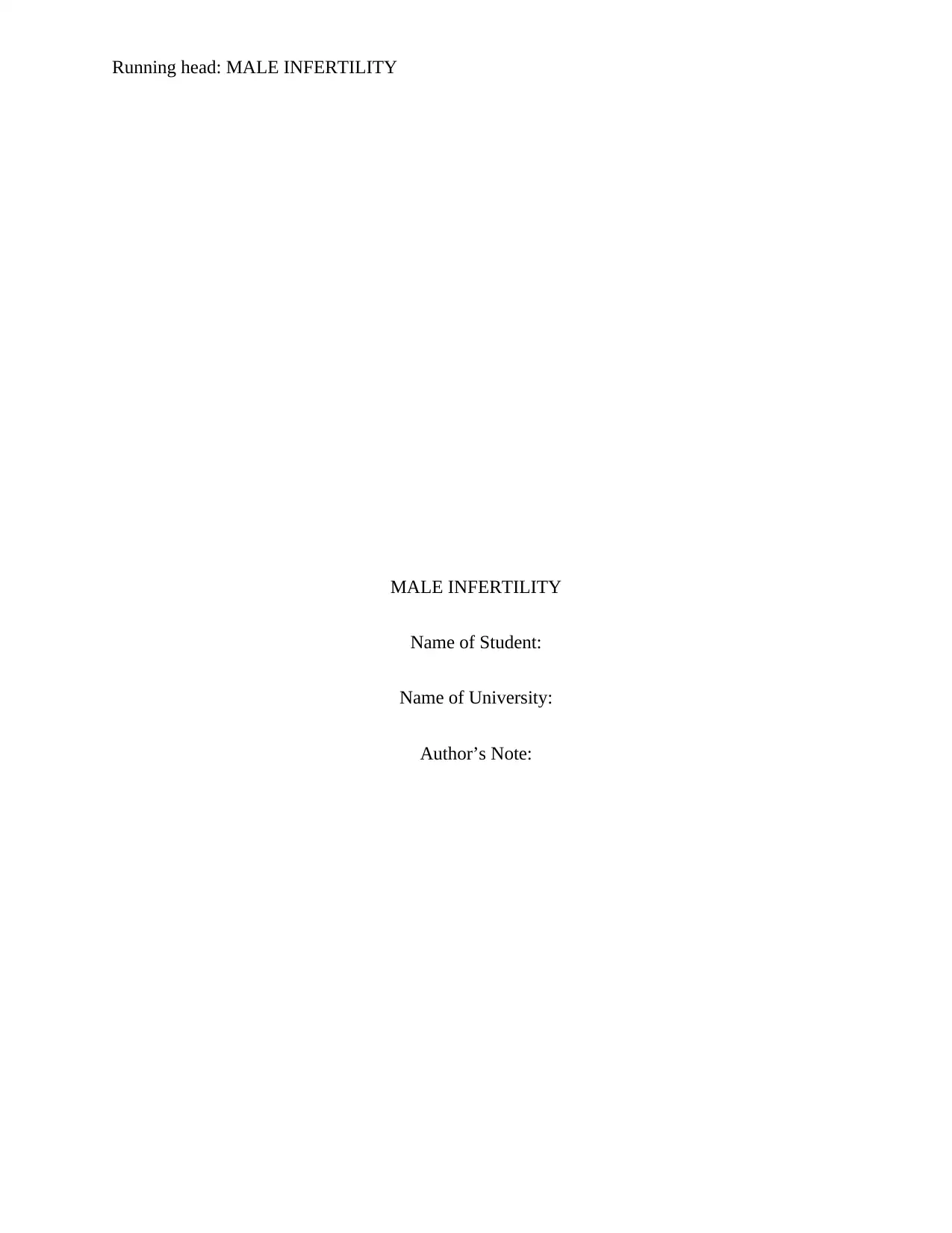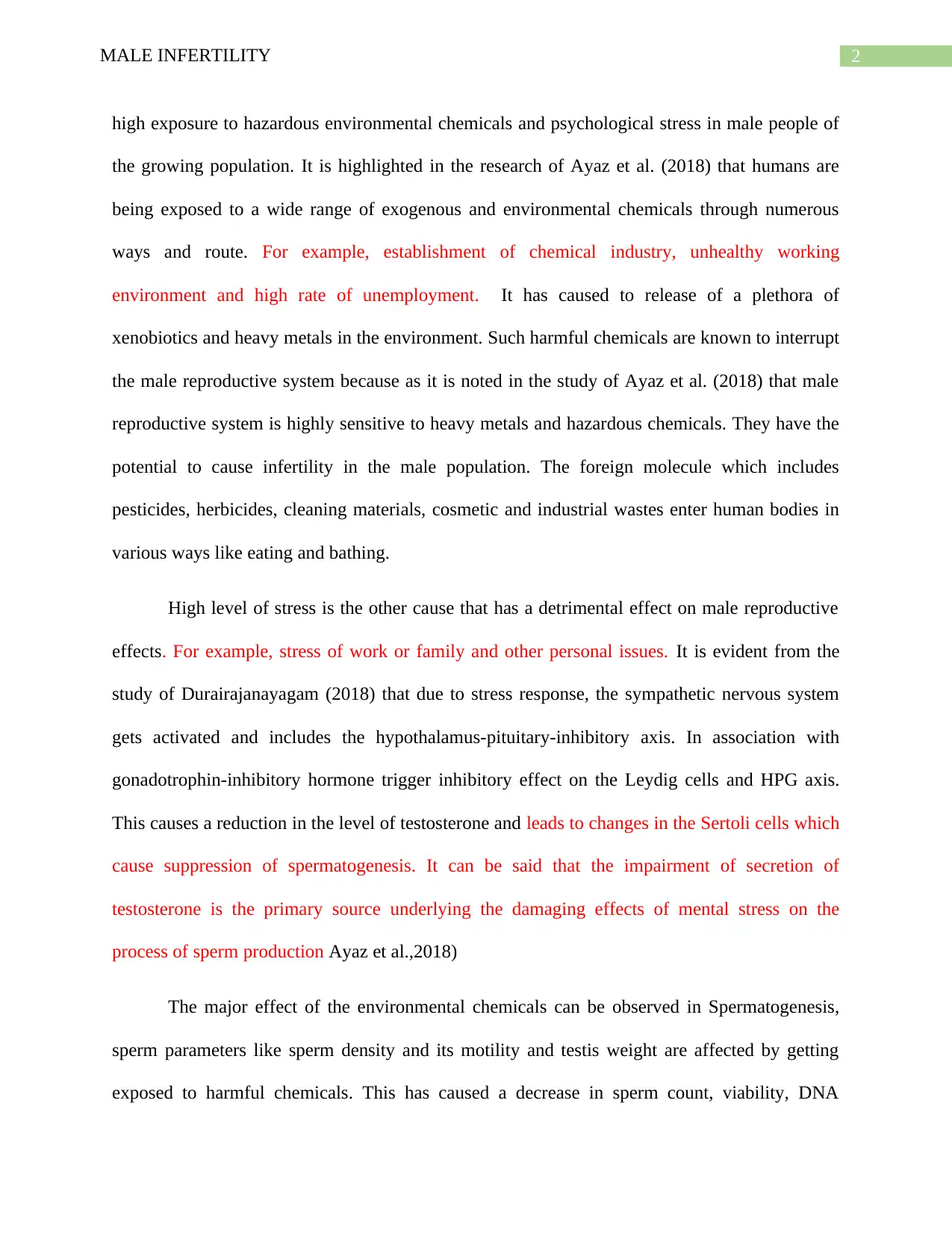Male Infertility: Exploring Causes, Effects, and Implications
VerifiedAdded on 2022/10/01
|6
|1487
|398
Essay
AI Summary
This essay delves into the multifaceted issue of male infertility, a significant health concern impacting couples globally. It begins by defining infertility and highlighting the male factor's contribution to the problem, particularly in the Australian population. The essay explores the causes of male infertility, including genetic abnormalities, anatomical changes, and exposure to environmental chemicals and psychological stress. It emphasizes the impact of these factors on sperm production, semen quality, and the overall male reproductive system. The essay also examines the effects of these factors, such as decreased sperm count, DNA damage, and hormonal imbalances. Ultimately, the essay underscores the importance of understanding these causes and effects to improve reproductive health and increase the chances of conception, advocating for lifestyle changes and increased awareness.

Running head: MALE INFERTILITY
MALE INFERTILITY
Name of Student:
Name of University:
Author’s Note:
MALE INFERTILITY
Name of Student:
Name of University:
Author’s Note:
Paraphrase This Document
Need a fresh take? Get an instant paraphrase of this document with our AI Paraphraser

1MALE INFERTILITY
Male infertility is one of the major health complications in Australia population and has
contributed to the failure in conceiving among 50% of the couples which causes significant
marital and psychosocial stress (Jungwirth et al., 2015). The term infertility is defined as the
inability to conceive after the period of one year of unprotected and regular sex. The male factor
contributes to 30% of the case of male infertility. It is a global problem. However, there is a lack
of accurate data and statistic to determine the rate of male infertility. The normal male fertility
depends on the production and transport of sperm which is depended on the functioning of the
endocrine gland and release of the hormone. When examining the fertility potential of the male
population, it depicts an essential part of the evaluation of the couples who fail to become
pregnant. However, it should be noted that the assessment must be done simultaneously with the
female partner. It is reported that in Australia, 18% of the minimum cases, male fertility test is
where the fertility prognosis is compromised and additionally misses a chance to improve the
health of the male patient. Thus, the main aim of the paper is to discuss male infertility referring
to its cause, and effect of male infertility.
Male infertility is mainly caused by a wide range of reason and condition which are often
ignored. It is reported in the study of (Jungwirth et al. (2015) that genetic abnormalities,
anatomical changes, neurological and systemic disease, iatrogenic injury, gonadotoxins,
infection trauma and production of the sperm antibodies are the primary reason for the high rate
of male infertility. Such causative elements have resulted in a defect in the production of sperm
and secretion of the low level of the hormone by the pituitary gland. In the study of Glazer et al.
(2018), genetic mutation or changes in the chromosome are responsible for male infertility.
There are numerous causes that is associated with male infertility that are contributing to
high rate failure in conceiving a child. The two primary reasons and cause for male infertility are
Male infertility is one of the major health complications in Australia population and has
contributed to the failure in conceiving among 50% of the couples which causes significant
marital and psychosocial stress (Jungwirth et al., 2015). The term infertility is defined as the
inability to conceive after the period of one year of unprotected and regular sex. The male factor
contributes to 30% of the case of male infertility. It is a global problem. However, there is a lack
of accurate data and statistic to determine the rate of male infertility. The normal male fertility
depends on the production and transport of sperm which is depended on the functioning of the
endocrine gland and release of the hormone. When examining the fertility potential of the male
population, it depicts an essential part of the evaluation of the couples who fail to become
pregnant. However, it should be noted that the assessment must be done simultaneously with the
female partner. It is reported that in Australia, 18% of the minimum cases, male fertility test is
where the fertility prognosis is compromised and additionally misses a chance to improve the
health of the male patient. Thus, the main aim of the paper is to discuss male infertility referring
to its cause, and effect of male infertility.
Male infertility is mainly caused by a wide range of reason and condition which are often
ignored. It is reported in the study of (Jungwirth et al. (2015) that genetic abnormalities,
anatomical changes, neurological and systemic disease, iatrogenic injury, gonadotoxins,
infection trauma and production of the sperm antibodies are the primary reason for the high rate
of male infertility. Such causative elements have resulted in a defect in the production of sperm
and secretion of the low level of the hormone by the pituitary gland. In the study of Glazer et al.
(2018), genetic mutation or changes in the chromosome are responsible for male infertility.
There are numerous causes that is associated with male infertility that are contributing to
high rate failure in conceiving a child. The two primary reasons and cause for male infertility are

2MALE INFERTILITY
high exposure to hazardous environmental chemicals and psychological stress in male people of
the growing population. It is highlighted in the research of Ayaz et al. (2018) that humans are
being exposed to a wide range of exogenous and environmental chemicals through numerous
ways and route. For example, establishment of chemical industry, unhealthy working
environment and high rate of unemployment. It has caused to release of a plethora of
xenobiotics and heavy metals in the environment. Such harmful chemicals are known to interrupt
the male reproductive system because as it is noted in the study of Ayaz et al. (2018) that male
reproductive system is highly sensitive to heavy metals and hazardous chemicals. They have the
potential to cause infertility in the male population. The foreign molecule which includes
pesticides, herbicides, cleaning materials, cosmetic and industrial wastes enter human bodies in
various ways like eating and bathing.
High level of stress is the other cause that has a detrimental effect on male reproductive
effects. For example, stress of work or family and other personal issues. It is evident from the
study of Durairajanayagam (2018) that due to stress response, the sympathetic nervous system
gets activated and includes the hypothalamus-pituitary-inhibitory axis. In association with
gonadotrophin-inhibitory hormone trigger inhibitory effect on the Leydig cells and HPG axis.
This causes a reduction in the level of testosterone and leads to changes in the Sertoli cells which
cause suppression of spermatogenesis. It can be said that the impairment of secretion of
testosterone is the primary source underlying the damaging effects of mental stress on the
process of sperm production Ayaz et al.,2018)
The major effect of the environmental chemicals can be observed in Spermatogenesis,
sperm parameters like sperm density and its motility and testis weight are affected by getting
exposed to harmful chemicals. This has caused a decrease in sperm count, viability, DNA
high exposure to hazardous environmental chemicals and psychological stress in male people of
the growing population. It is highlighted in the research of Ayaz et al. (2018) that humans are
being exposed to a wide range of exogenous and environmental chemicals through numerous
ways and route. For example, establishment of chemical industry, unhealthy working
environment and high rate of unemployment. It has caused to release of a plethora of
xenobiotics and heavy metals in the environment. Such harmful chemicals are known to interrupt
the male reproductive system because as it is noted in the study of Ayaz et al. (2018) that male
reproductive system is highly sensitive to heavy metals and hazardous chemicals. They have the
potential to cause infertility in the male population. The foreign molecule which includes
pesticides, herbicides, cleaning materials, cosmetic and industrial wastes enter human bodies in
various ways like eating and bathing.
High level of stress is the other cause that has a detrimental effect on male reproductive
effects. For example, stress of work or family and other personal issues. It is evident from the
study of Durairajanayagam (2018) that due to stress response, the sympathetic nervous system
gets activated and includes the hypothalamus-pituitary-inhibitory axis. In association with
gonadotrophin-inhibitory hormone trigger inhibitory effect on the Leydig cells and HPG axis.
This causes a reduction in the level of testosterone and leads to changes in the Sertoli cells which
cause suppression of spermatogenesis. It can be said that the impairment of secretion of
testosterone is the primary source underlying the damaging effects of mental stress on the
process of sperm production Ayaz et al.,2018)
The major effect of the environmental chemicals can be observed in Spermatogenesis,
sperm parameters like sperm density and its motility and testis weight are affected by getting
exposed to harmful chemicals. This has caused a decrease in sperm count, viability, DNA
⊘ This is a preview!⊘
Do you want full access?
Subscribe today to unlock all pages.

Trusted by 1+ million students worldwide

3MALE INFERTILITY
damage of sperm and abnormal morphology of sperm. It Thus, the cause leads to the detrimental
effect on the male reproductive system that has cause to decrease in weight of testes, seminal
vesicle and degeneration of seminiferous tubules (Jenardhanan, Panneerselvam & Mathur, 2016).
This has led to a reduction of secretion of FSH, LH and antioxidant enzymes that have also
inhibited steroidogenesis that results in male infertility. Research has clarified that chemicals
molecules tend to mimic estrogen hormone and a disruptor of the endocrine gland and its
function. This has caused a delay in maturity of sperm in the epididymis and its low production.
It has affected their health and led to high prevalence of endocrine issues like prostate cancer
(Durairajanayagam, 2018)
The effect of High level of stress can be inferred by the study by Krausz, Escamilla and
Chianese (2018) as they have investigated the connection between the psychological stress of life
and semen quality. The author has found that it has a negative effect on the semen quality and
high rate of DNA damage of the sperm. For example, it led to reduced paternity and the high rate
of male infertility in the growing population (Jungwirth et al., 2015). It not only affects the
reproductive system but leads to a high prevalence of various health issue like obesity and
cardiovascular complication. Due to change in the hormone level, there is disruption in the
function of sperm secretion.
Lastly, from the above discussion, it can be said that male infertility is the most prevalent
reason due to which female is unable to conceive. There are a variety of cause s which has
contributed to male infertility which influence sperm quality. It includes the lifestyle factors like
cigarette smoking, use of illicit drugs, obesity, exposure to harmful chemical and psychological
stress. The impact of these factors can be intensified and carried from generation to generation.
Such a high rate of causative factors can be overcome by the making changes in the behaviour
damage of sperm and abnormal morphology of sperm. It Thus, the cause leads to the detrimental
effect on the male reproductive system that has cause to decrease in weight of testes, seminal
vesicle and degeneration of seminiferous tubules (Jenardhanan, Panneerselvam & Mathur, 2016).
This has led to a reduction of secretion of FSH, LH and antioxidant enzymes that have also
inhibited steroidogenesis that results in male infertility. Research has clarified that chemicals
molecules tend to mimic estrogen hormone and a disruptor of the endocrine gland and its
function. This has caused a delay in maturity of sperm in the epididymis and its low production.
It has affected their health and led to high prevalence of endocrine issues like prostate cancer
(Durairajanayagam, 2018)
The effect of High level of stress can be inferred by the study by Krausz, Escamilla and
Chianese (2018) as they have investigated the connection between the psychological stress of life
and semen quality. The author has found that it has a negative effect on the semen quality and
high rate of DNA damage of the sperm. For example, it led to reduced paternity and the high rate
of male infertility in the growing population (Jungwirth et al., 2015). It not only affects the
reproductive system but leads to a high prevalence of various health issue like obesity and
cardiovascular complication. Due to change in the hormone level, there is disruption in the
function of sperm secretion.
Lastly, from the above discussion, it can be said that male infertility is the most prevalent
reason due to which female is unable to conceive. There are a variety of cause s which has
contributed to male infertility which influence sperm quality. It includes the lifestyle factors like
cigarette smoking, use of illicit drugs, obesity, exposure to harmful chemical and psychological
stress. The impact of these factors can be intensified and carried from generation to generation.
Such a high rate of causative factors can be overcome by the making changes in the behaviour
Paraphrase This Document
Need a fresh take? Get an instant paraphrase of this document with our AI Paraphraser

4MALE INFERTILITY
and lifestyle. In this way, the harmful effect of such factors on the male reproductive system can
be alleviated and cause the favourable result. However, the most important part is creating
awareness of the cause s and cause of male infertility with the objective of improving the
conceiving rate of the female population.
and lifestyle. In this way, the harmful effect of such factors on the male reproductive system can
be alleviated and cause the favourable result. However, the most important part is creating
awareness of the cause s and cause of male infertility with the objective of improving the
conceiving rate of the female population.

5MALE INFERTILITY
Reference
Ayaz, A., Kothandaraman, N., Henkel, R., & Sikka, S. C. (2018). Impact of environmental
factors on the genomics and proteomics landscapes of male infertility.
In Bioenvironmental Issues Affecting Men's Reproductive and Sexual Health (pp. 335-
353). Academic Press. Retrieved from https://doi.org/10.1016/B978-0-12-801299-4.00021-
9
Durairajanayagam, D. (2018). Lifestyle causes of male infertility. Arab journal of urology, 16(1),
10-20. Retrieved from https://doi.org/10.1016/B978-0-12-801299-4.00021-9
Glazer, C. H., Tøttenborg, S. S., Giwercman, A., Bräuner, E. V., Eisenberg, M. L., Vassard,
D., ... & Bonde, J. P. (2018). Male factor infertility and risk of multiple sclerosis: A
register-based cohort study. Multiple Sclerosis Journal, 24(14), 1835-1842. Retrieved from
https://doi.org/10.1177%2F1352458517734069
Jenardhanan, P., Panneerselvam, M., & Mathur, P. P. (2016, November). Effect of
environmental contaminants on spermatogenesis. In Seminars in cell & developmental
biology (Vol. 59, pp. 126-140). Academic Press. Retrieved from
https://www.sciencedirect.com/science/article/pii/S1084952116300854
Jungwirth, A., Diemer, T., Dohle, G. R., Giwercman, A., Kopa, Z., Krausz, C., & Tournaye, H.
(2015). Guidelines on male infertility. Eur Urol, 62, 324-332. Retrieved from
https://uroweb.org/wp-content/uploads/15-Male-Infertility_LR1.pdf
Reference
Ayaz, A., Kothandaraman, N., Henkel, R., & Sikka, S. C. (2018). Impact of environmental
factors on the genomics and proteomics landscapes of male infertility.
In Bioenvironmental Issues Affecting Men's Reproductive and Sexual Health (pp. 335-
353). Academic Press. Retrieved from https://doi.org/10.1016/B978-0-12-801299-4.00021-
9
Durairajanayagam, D. (2018). Lifestyle causes of male infertility. Arab journal of urology, 16(1),
10-20. Retrieved from https://doi.org/10.1016/B978-0-12-801299-4.00021-9
Glazer, C. H., Tøttenborg, S. S., Giwercman, A., Bräuner, E. V., Eisenberg, M. L., Vassard,
D., ... & Bonde, J. P. (2018). Male factor infertility and risk of multiple sclerosis: A
register-based cohort study. Multiple Sclerosis Journal, 24(14), 1835-1842. Retrieved from
https://doi.org/10.1177%2F1352458517734069
Jenardhanan, P., Panneerselvam, M., & Mathur, P. P. (2016, November). Effect of
environmental contaminants on spermatogenesis. In Seminars in cell & developmental
biology (Vol. 59, pp. 126-140). Academic Press. Retrieved from
https://www.sciencedirect.com/science/article/pii/S1084952116300854
Jungwirth, A., Diemer, T., Dohle, G. R., Giwercman, A., Kopa, Z., Krausz, C., & Tournaye, H.
(2015). Guidelines on male infertility. Eur Urol, 62, 324-332. Retrieved from
https://uroweb.org/wp-content/uploads/15-Male-Infertility_LR1.pdf
⊘ This is a preview!⊘
Do you want full access?
Subscribe today to unlock all pages.

Trusted by 1+ million students worldwide
1 out of 6
Related Documents
Your All-in-One AI-Powered Toolkit for Academic Success.
+13062052269
info@desklib.com
Available 24*7 on WhatsApp / Email
![[object Object]](/_next/static/media/star-bottom.7253800d.svg)
Unlock your academic potential
Copyright © 2020–2025 A2Z Services. All Rights Reserved. Developed and managed by ZUCOL.




